
A comprehensive study provides guidelines on when to neuter various dog breeds to avoid health risks. Particular dog breeds would be at higher risk from joint disorders and certain cancers if they were spayed or neutered in their first year.
Past studies only assessed this phenomenon in some breeds. A new study completed by the University of California Davis researchers studied 35 breeds of dogs for ten years. The study, published in Frontiers in Veterinary Science, found that the specific breed determines if neutering causes the vulnerability.
Professor emeritus Benjamin Hart from the UC Davis School of Veterinary Medicine and lead study author says different dog breeds exhibit huge disparity in certain aspects. According to Hart, health risks, age, and breed are important considerations in neutering a dog. He says some breeds develop problems, such as joint disorders or cancer.
The researchers analyzed data from thousands of UC Davis Veterinary Medical Teaching Hospital patient records spanning 15 years to determine if neutering age and sex differences predispose different dog breeds to certain joint disorders and cancers across. Among the examined joint disorders are cranial cruciate ligament tears, elbow dysplasia, and hip dysplasia. The various cancers considered include hemangiosarcoma, lymphoma, osteosarcoma, and mast cell tumors. The age of dog neutering was not found to affect the risk of such problems.
The study authors discovered that body size was a factor in developing joint disorders. Study co-author and UC Davis School of Veterinary Medicine professor Lynette Hart says that smaller breeds do not have such problems, while most large breeds are susceptible to them. A surprising exception, however, involves the giant Irish Wolfhound and Great Dane, which have no increased joint disorder risk regardless of the age when they were neutered.
The study also found that cancers were low in smaller breeds regardless of being neutered or not. Two small breeds, the Shih Tzu and Boston Terrier, had a significant risk of diseases when neutered.
The sex of dogs also sometimes had a significant effect when they are neutered. Boston Terrier females who were neutered at six months old did not have a higher risk of cancers or joint disorders compared to intact dogs. However, the male of the breed neutered at an age earlier than one year had a significantly high risk.
Past studies showed that spaying or neutering golden retriever females of any age corresponded to an increase in the risk of several cancers ranging from 5-15%.
Dog owners from the US are beginning to choose to spay or neuter their pets overwhelmingly. This is mostly due to a concern of overpopulation of dogs, euthanasia, or reducing the volume of shelter dogs. Veterinarians in the United States usually practice surgical neutering on dogs by the sixth month of age.
The new study suggests careful consideration of the breed, age, and sex of dogs in deciding when to neuter or spay them. Hart says that ultimately, it is the pet owner's decision if and when they should neuter or spay their dog, naturally together in consultation with a veterinarian. The results of the study present a paradigm shift regarding the most common surgical operation in the practice of veterinary medicine.
The published study outlines the guidelines for 35 dog breeds that veterinarians and pet owners can consult in deciding when to decide to neuter. It can be accessed here.
© 2025 NatureWorldNews.com All rights reserved. Do not reproduce without permission.





